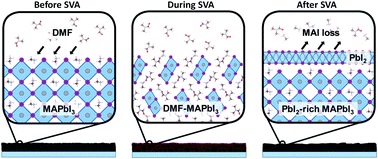Solvent vapour annealing of methylammonium lead halide perovskite: what's the catch?†
Abstract
Solvent vapour annealing (SVA) is a common post-processing technique used to increase the average grain size of lead halide perovskite films and thus enhance device performance. The prevailing wisdom is that large grain perovskite films lead to enhanced stability, however, we observed the reverse in CH3NH3PbI3 (MAPbI3) with dimethylformamide vapour treatment compared to non-SVA controls. Using a range of microstructural characterisation techniques, we reveal that SVA is not a chemically benign grain-growth process, but leads to substantial stoichiometric changes in the perovskite films. Intrinsic material degradation is investigated under external loading with in situ X-ray scattering, and combined with lifetime testing on full devices. We show that the operational stability of SVA devices greatly depends on the initial stoichiometry of the MAPbI3 with PbI2-excess compositions being least stable. However, the incorporation of excess organic-halides in the precursor solution helps to mitigate the deleterious effects of SVA on device stability. This work critically re-evaluates current thinking around grain structure and stoichiometry in achieving long-term stability for perovskite solar cells.



 Please wait while we load your content...
Please wait while we load your content...